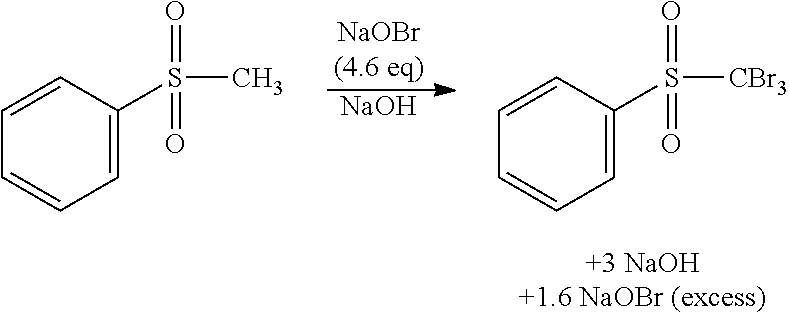A process for making brominating agents in flow
a brominating agent and flow technology, applied in the field of flow-making brominating agents, can solve the problems of high intrinsic safety risk of handling and/or transporting liquid elemental bromine, low atom efficiency of brominating compounds per kilogram of reagent, and low economic value of reagents, etc., to achieve cost-effective and safe
- Summary
- Abstract
- Description
- Claims
- Application Information
AI Technical Summary
Benefits of technology
Problems solved by technology
Method used
Image
Examples
examples
[0046]All materials used in the following examples were readily available from standard sources such as Sigma-Aldrich (Belgium) and Acros (Belgium) unless otherwise specified. The target compounds used in the Examples are only illustrative to the invention.
1. Bromination with hypobromite
Synthesis of Sodium Hypobromite in Flow
[0047]Reaction Scheme:
NaBr+NaOCl→NaOBr+NaCl
Reaction procedure:[0048]Two aqueous solutions are prepared and combined in a flow reactor in order to generate a solution containing hypobromite:[0049]Solution A comprises a 40% w / w of sodium bromide in water (400 gram sodium bromide+600 gram water). Sodium bromide was purchased from Bromine Compounds Ltd (Israel) and dissolved in demineralized water to obtain a clear solution.[0050]Solution B is a commercially available concentrated bleach solution (13% by weight sodiumhypochlorite in water as determined by titration at Agfa Materials, product purchased from Acros Belgium, freshly used).[0051]Stream A was pumped throu...
PUM
| Property | Measurement | Unit |
|---|---|---|
| Reduction potential | aaaaa | aaaaa |
| Flow rate | aaaaa | aaaaa |
Abstract
Description
Claims
Application Information
 Login to View More
Login to View More - R&D
- Intellectual Property
- Life Sciences
- Materials
- Tech Scout
- Unparalleled Data Quality
- Higher Quality Content
- 60% Fewer Hallucinations
Browse by: Latest US Patents, China's latest patents, Technical Efficacy Thesaurus, Application Domain, Technology Topic, Popular Technical Reports.
© 2025 PatSnap. All rights reserved.Legal|Privacy policy|Modern Slavery Act Transparency Statement|Sitemap|About US| Contact US: help@patsnap.com

